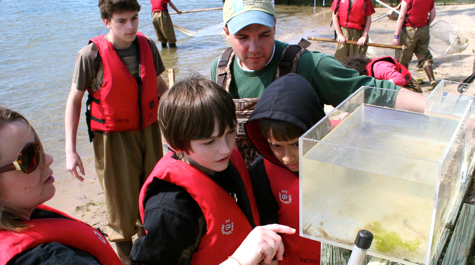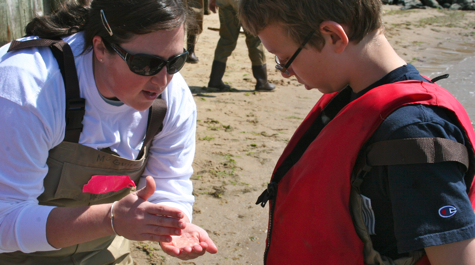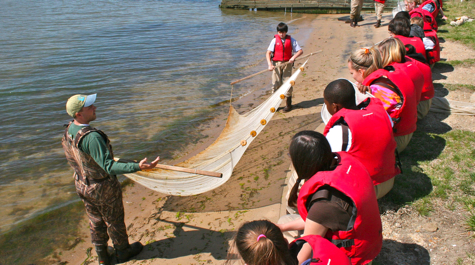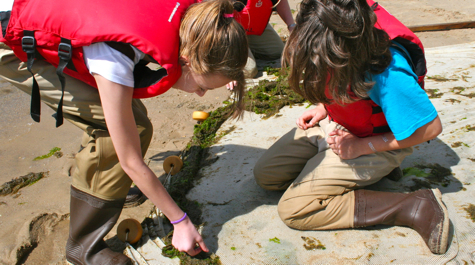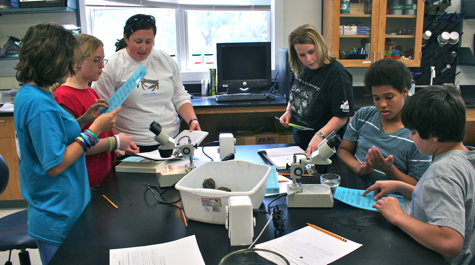VIMS program helps ensure that no child is left inside
Thanks to the Virginia Institute of Marine Science, seventh graders in Gloucester, Mathews, and York counties have a new dress code: waders and a life jacket.
The students and their teachers are part of an ongoing and newly expanded educational program offered by the Chesapeake Bay National Estuarine Research Reserve at VIMS. CBNERR Education Coordinator Sarah McGuire heads the effort, which is designed to provide every student in the three counties with Bay-focused field and classroom experiences during their 7th-grade year.
This year’s program is the first to target middle schools in York County (currently Yorktown and Grafton). Each year between 2005 and 2010, it reached all 7th-grade students at Page and Peasley middle schools in Gloucester County and Thomas Hunter Middle School in Mathews County.
“The Chesapeake 2000 Agreement mandated that all students must have a meaningful Chesapeake Bay watershed experience before they graduate from high school,” says McGuire. “Our program, Chesapeake Studies for Virginia Middle Schools, does just that.”
The program combines a full-day field trip to VIMS, a pair of visits by CBNERR scientists to the student’s own biology classrooms, and ongoing instruction by the students’ regular life-science teachers. Teacher training ensures that the program will continue into future years.
“We try to provide each and every student with a hands-on field experience that is deeply integrated into their standard curriculum,” says McGuire. “We use the Bay as a major theme to address Virginia’s SOLs [Standards of Learning] for Life Science, and provide professional development for local teachers so that they can bring Chesapeake Bay activities into their own classrooms.”
To date, nearly all of the Life Science teachers at middle schools in the three counties have participated, most recently during a 3-day Chesapeake Studies in the Classroom course last summer. In addition to their newfound knowledge, the participating teachers leave the course with a Chesapeake Studies Teacher’s Manual, lessons plans, and two aquaria with all necessary supplies.
“Our ultimate goal,” McGuire says “is to create a sustainable program so that local middle schools can continue to provide meaningful Bay experiences for their students well into the future.
Dr. William Reay, Director of the CBNERR program at VIMS, says “The Chesapeake Studies program will in two years nearly double the number of students we’ve reached. Gloucester and Mathews schools have been extremely excited about working with our education staff in the past, and York County is really looking forward to the Chesapeake Studies program expanding into their schools.”
Field trip to VIMS
During the most recent field trip to VIMS, Jennifer Gonzalez and her 7th-grade Life Science class from Grafton Middle School spent a fun and educational day studying the Bay and its creatures; first during an oyster-reef exercise in CBNERR’s Catlett-Burress Laboratory and later in the shallow waters of the York River aside the VIMS campus in Gloucester Point.
Scott Markwith, CBNERR Marine Education Specialist, led the in-water portion of the field trip. He first helped the students don their waders and life jackets, and then instructed them in proper use of dip nets and pull-seines before they entered the shallow, seaweed-strewn waters.
The rapport between the students and Markwith and the other teachers is obvious. “This is great for catching slower moving critters like snails, hermit crabs, and grass shrimp,” Markwith says of his dip net. “Just try to be as stealthy as possible.” “Like a ninja!” one student shouts. “Like a predator’s mouth,” answers Markwith.
Markwith comes by his connection with the visiting students honestly. He was himself a field-trip visitor to VIMS while a student at Page Middle School in 1999, and credits that experience with nurturing his own interest in marine science.
In the water
During their time in the water, the 20-plus Grafton students use their nets to sample a broad and colorful variety of marine life including red beard sponges; blue crabs; pipefish; sea lettuce; grass, sand, and skeleton shrimp; amphipods; oysters; hermit crabs; sea squirts; comb jellies; mummichogs; American eels; skilletfish; mud snails; jellyfish; “brown fuzz;” and even a rarely seen spotted hake.
The students also learn to use probes to measure the saltiness of the water (25 parts per thousand compared to the 35 ppt of full seawater), levels of dissolved oxygen (a very high reading of 14 milligrams per liter), and water clarity (65 units on a scale that starts at zero with clear water). Their temperature sensor confirms what their feet and hands are telling them: the water is chilly at 15.5°Celsius (60° F).
But the chilly water does little to hamper the students’ excitement and enthusiasm, as their frequent exclamations of discovery and joy attest. “They’re focused on what they’re doing,” says Gonzalez. “They’re excited about finding species and identifying them. It’s been great.”
NOAA B-WET Program
The Chesapeake Studies for Virginia Middle Schools program is funded by a series of one-year grants from NOAA’s B-WET Program (for Bay Watershed Education and Training). This year’s expanded version of the local B-WET program will reach more than 1,000 students: 650 in Gloucester and Mathews County and 560 in York County. During its six-year run to date, the program has reached more than 3,200 young learners.
NOAA’s larger Chesapeake B-WET program, which was established in 2002, operates in all six Bay watershed states (Maryland, Virginia, Delaware, West Virginia, Pennsylvania, and New York) and the District of Columbia. It has been so successful that it has grown into a national network that provides hands-on watershed education to students and teachers across the U.S. Other B-WET programs now reach students in California; Hawai'i; the states along the Gulf of Mexico; New England; and the Pacific Northwest.
CBNERR
Designated in 1991, the Chesapeake Bay National Estuarine Research Reserve is one of 27 protected areas that make up the National Estuarine Research Reserve System. NOAA established the reserve system to promote informed management of the Nation's estuaries and coastal habitats. CBNERR is administered as a partnership between NOAA and the Commonwealth of Virginia. The Reserve is managed on a daily basis by VIMS.
VIMS is an independent state agency that conducts marine research today for a healthier tomorrow. The School of Marine Science at VIMS is a graduate school of the College of William and Mary.

